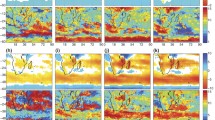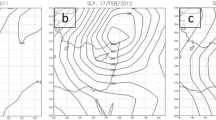Abstract
Though the East African monsoons may be considered as mere extensions of the South Asian monsoonal system, they possess a number of characteristics which make them unique amongst the world's monsoons. The most important of these is the relative dryness of both the North and the South monsoon, caused by a prevalent low-level divergence over eastern Africa. Most rainfall in the region therefore occurs during the intermediate seasons between the monsoons, when this divergence is temporarily replaced by more convergent flow patterns. As a result, total rainfall in East Africa is relatively low. Over most of the region it is strongly concentrated during two short seasons and it is highly variable from year to year, both in total amount and in time of occurrence.
As in most parts of the tropics, rainfall is the main limiting factor in agricultural production in East Africa. The relations between rainfall and agriculture can be illustrated by the usual water balances, but an alternative method, employing the Agricultural Rainfall Indicator, is more useful for planning purposes. Drought frequencies, based on a simple relation between actual and average rainfall, also represent the effects of the monsoons on East African agriculture very clearly.
Similar content being viewed by others
References
East African Meteorological Department: Monthly and annual rainfall in Uganda, Kenya and Tanganyika and Zanzibar for the period 1931–1960. 33, 172 and 105 pages (1965, 1966)
East African Meteorological Department: Mean annual Rainfall Map of East Africa. 2 sheets, 1971.
East Africa Royal Commission: Report for 1953–1955. London, pp. 252–254 and Map 3, 1961.
Flohn, H.: Über die Ursachen der Aridität Nordost-Afrikas. Würzburger Geogr. Arb., 12, 25–41 (1964)
Glantz, M.H. and Katz, R.W.: When is a drought a drought? Nature. 267 (5608), 192–193 (1977)
GRIFFITHS, J.F.: The Climate of East Africa. In: East Africa, its people and resources. Morgan, W.T.W., ed., pp. 110–113, 1969.
Johnson, D.H.: Rain in East Africa. Quarterly Journal of the Royal Met. Society. 88, 1–19 (1962)
NIEUWOLT, S.: Rainfall and Evaporation in Tanzania. BRALUP Research Paper Nr. 24, Dar es Salaam, p. 7 (1973)
Nieuwolt, S.: Seasonal rainfall distribution in Tanzania and its cartographic representation. Erdkunde, 28, 186–194 (1974)
Nieuwolt, S.: Rainfall variability and drought frequencies in East Africa. Erdkunde, 32, 81–88 (1978)
OBASI, G.O.P. and KIANGI, P.M.R.: Water Balance in Kenya. p. 3, 4, 1973.
RAMAGE, C.S.: Monsoon Meteorology. pp. 3–6, New York, 1971.
Thornthwaite, C.W.: An approach toward a rational classification of climate. Geogr. Review, 38, 55–94 (1948)
Thornthwaite, C.W. and Mather, J.R.: Instructions and Tables for Computing Potential Evapotranspiration and the Water Balance. pp. 243–311, Centerton, N.J., 1957.
Woodhead, T.: The Water Balance as a guide to site potential. Journal of Applied Ecology, 7, 647–652 (1970)
Author information
Authors and Affiliations
Rights and permissions
About this article
Cite this article
Nairobi, N.S. The East African monsoons and their effects on agriculture. Geojournal 3, 193–200 (1979). https://doi.org/10.1007/BF00257708
Issue Date:
DOI: https://doi.org/10.1007/BF00257708




